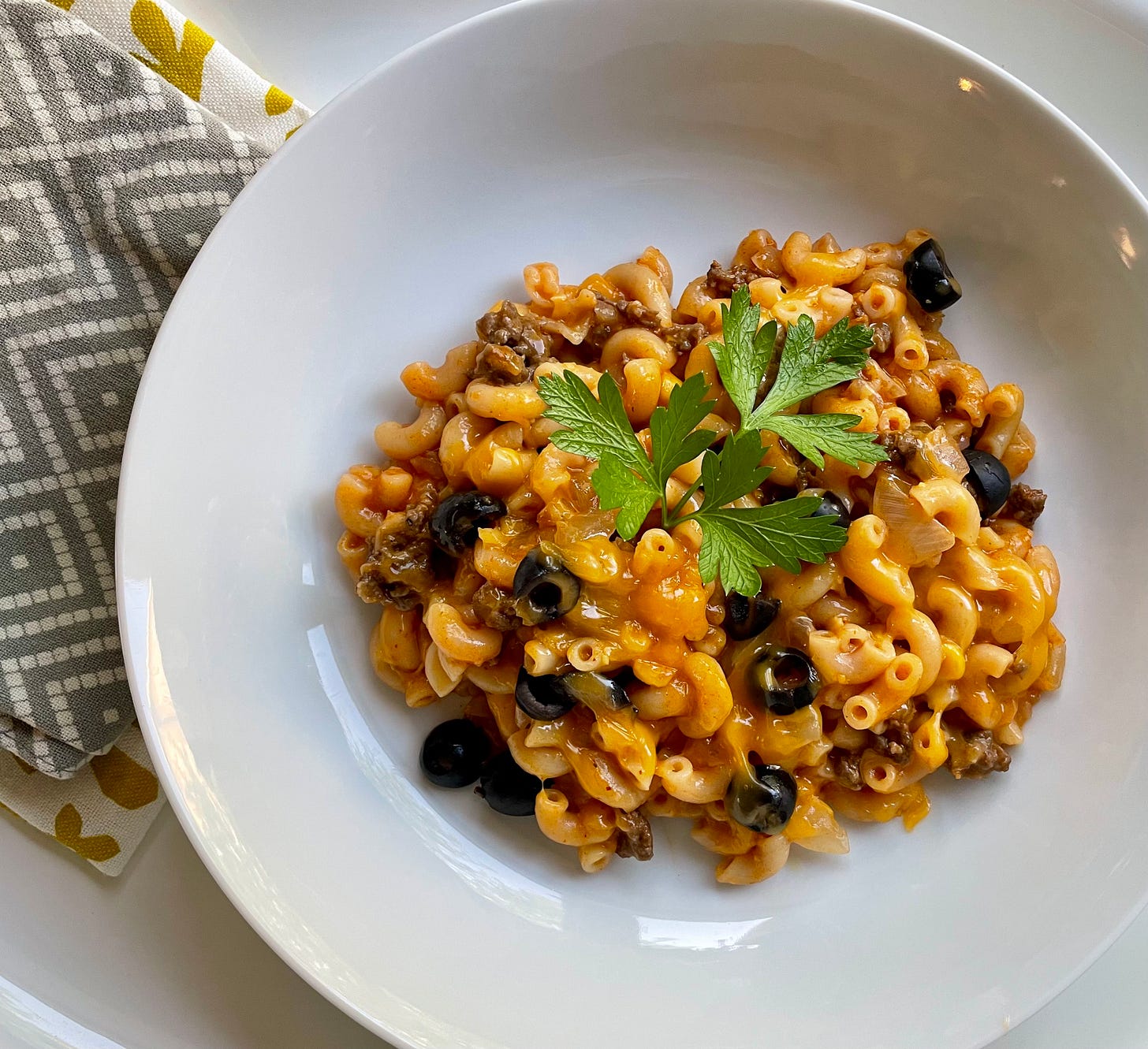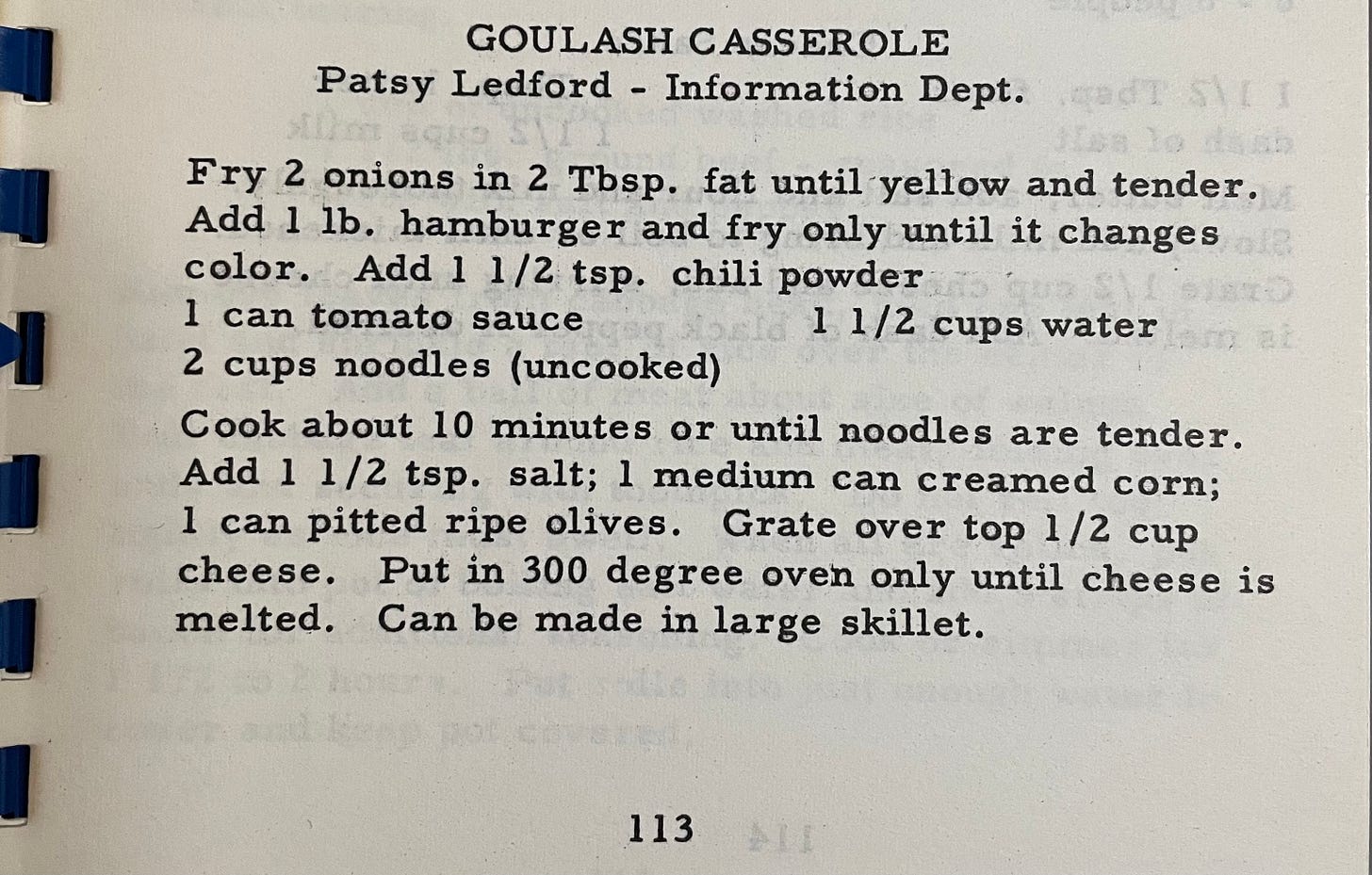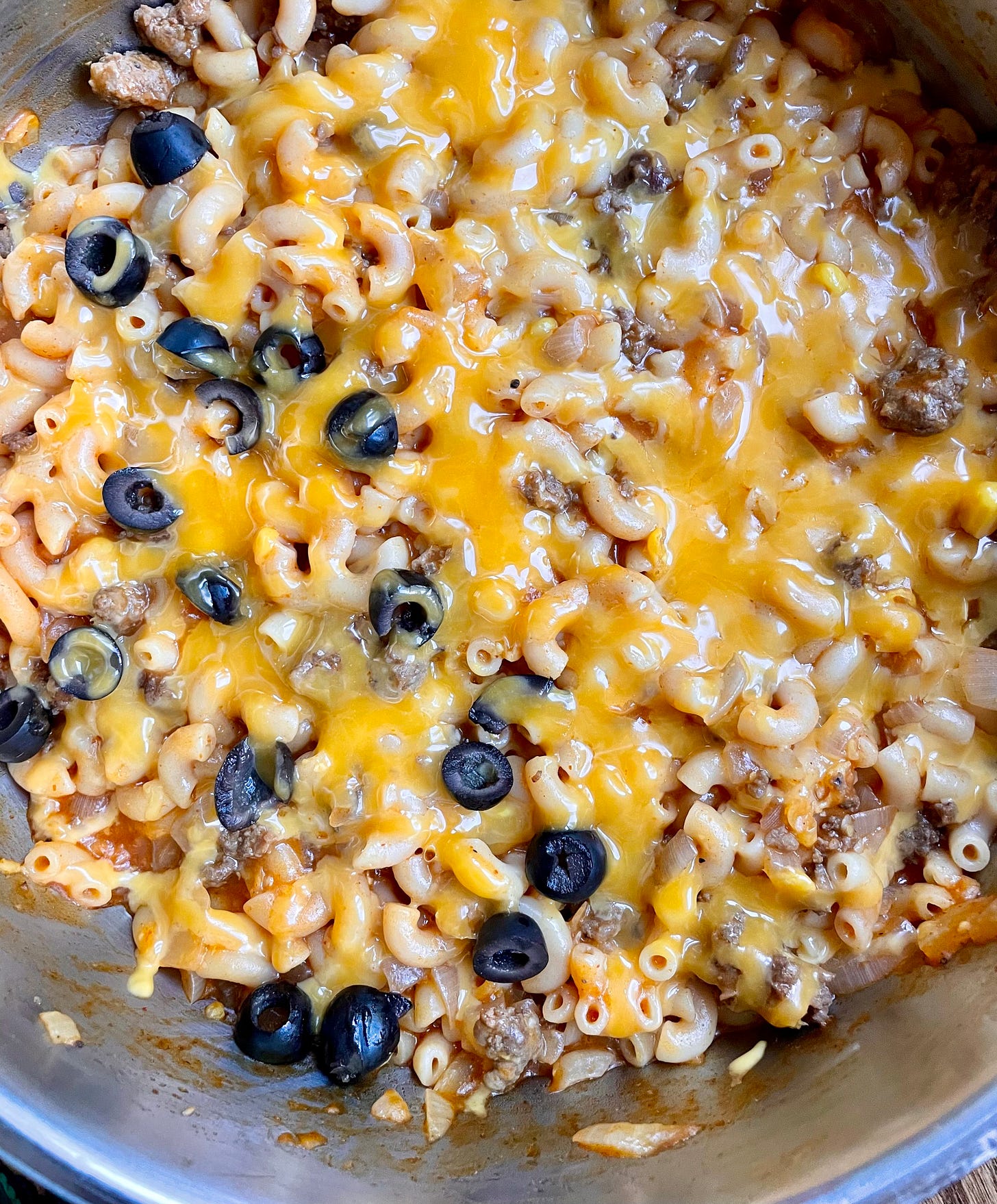Vintage Recipe Roulette: Creamed Corn Goulash from the 1960s
This is not your elementary school cafeteria's goulash
Every time I talk to anyone about a goulash recipe, they say, “What is goulash, anyway?” Well, it depends on what your definition of “is” is…
Real Hungarian Gulyás or goulash is shepherd food dating back over a thousand years, although at the time it wouldn’t have had New World food like peppers, tomatoes, and potatoes in it — they didn’t make it to Europe until the 1500s at the earliest, and potatoes took a couple hundred years to be really popular. Before then, it was probably turnips, celery root, and sour cream. I often think about how foods we think of as traditional are actually yesterday’s curried tuna-pineapple casseroles, incorporating exciting foreign ingredients of the time into familiar favorites. For the last half millennium, though, goulash has been a beef stew with root vegetables, sweet peppers, tomato, caraway, and A LOT of paprika in it. There’s not a noodle in sight.
And that may surprise you if your frame of reference is late 20th-century American school cafeteria food, where it is ground meat, tomato, pasta (usually macaroni noodles), maybe cheese, and it’s not very stew-like. It’s more like Hamburger Helper — a pasta dish in meat sauce. There’s usually not much paprika in it, but occasionally schools would add kidney beans to stretch it a bit. That also makes it healthier, but I don’t think that was the motivation at the time.
To add further confusion, the same dish is, inexplicably, sometimes called American Chop Suey, especially in parts of the Midwest and northern East Coast. You can read the fabulous backstory on that here, but in short, the reasons for the conflation of the initial Americanized versions of Chinese chop suey (a sort of chicken stir-fry) with pasta and tomato-beef sauce are pretty murky.
Just like this casserole.
It may just be that it was an amalgamation of foods with a foreign-sounding name. When recipes get handed down by word of mouth or on the backs of envelopes, and there’s very little contact with other languages or cultures, things can get a little crazy. People may not have known that a word sounding something like “goulash” to American English ears was Hungarian, or that something sounding like “chop suey” was Chinese, much less which ingredients went with which place.
To add even more complexity, in a few spots like Maine, the same dish is occasionally called “slumgullion”, which is thought to be from old British English — a compound of words meaning “slime” and “cesspool”. Nice. I’ll bet that’s a home cook word for any mix of whatever you had, sort of the way we use words like “hash” or “chow” or “trash” now.
Regardless of all that, today’s recipe, again from the Design for Living Cookbook from the women of the Arkansas Southwestern Bell Telephone, is a goulash of another color; specifically, yellow.
I did find one other Southern recipe that uses canned whole corn, and one unique family recipe with creamed corn but no tomatoes or pasta, and goulash recipes only rarely appear with olives. This may be a personal variation from Ms. Ledford.
It sounds awful. Let’s try it! Here are the ingredients, although I’m just going to make half of the recipe:
Don’t be alarmed by the coloring of the ground beef — my husband often forms it into patties, sprinkles with Worcestershire and reduced sodium Montreal Steak Seasoning, and freezes in patties for ease of burger-ing, or incorporation into other meals like this one. It won’t alter the effect of the dish much. In addition to that, it’s onion, tomato sauce, macaroni, olives, cheese, (cringe) creamed corn, and a ludicrously small amount of chili powder. I’m leaving out the salt until I taste it at the end of simmering, because there is salt in the corn and the tomato sauce.
It’s quite easy to make — just cook the beef a little with the onion (as in other recently featured recipes, it specifies no pesky and delicious browning, hahahaha), add an infinitesimal amount of chili powder with water, pasta, and tomato sauce (it doesn’t say how much, so I took a big guess and went with the 8 oz can that a lot of vintage recipes call for, also considering the amount of water this recipe calls for), and simmer until the pasta is tender. Then, mix in olives, top with cheese, and place in the oven to melt that cheese…but again, no browning allowed!
But, I could tell immediately that there is not enough water called for in the dish, and I added another half cup. It could be that it was supposed to be a large can of tomato sauce? It might work differently with a different pasta shape or smaller pan, but it does say you can cook it in a skillet, and that’s what I chose to do for ease of oven-based cheese melting. I don’t think the doubled recipe would make much difference, though. Also, ten minutes is not enough time for tender pasta if it’s a larger noodle and cooked in ingredients other than water. It just takes longer for the water to diffuse in when there are other solutes in the water, like salt and potassium.



As is typically true of community cookbooks, there’s precious little instruction on getting a good result, because the recipes are not professionally written, and they assume any idiot knows you need to cover and stir it so it doesn’t dry out and stick like burned tar. Just know that if you’re following a vintage recipe, you need to fill in a lot of blanks.
It looked fine until it came time to add the creamed corn.
My husband is also going to eat this for dinner despite some serious misgivings, so I only put the olives on my half and didn’t mix them in. I also laughed at the ridiculously tiny amount of cheese and added another 1/4 c. Here it is all done.
It smells okay, but there’s an odd sweetness to the aroma. As for the flavor, well…odd sweetness about covers that, too. There’s no texture left from the corn, so it disappears except for the distinctly sugary pall cast over the whole. The olives really clash with that, too. It’s not like my elementary cafeteria’s goulash, but it does remind me of something, and after thinking about it for a few minutes, I realized it’s Chef Boyardee’s Beefaroni. It’s too sweet, too textureless…whole corn and diced tomatoes would have helped. We added a little salt and a lot of hot sauce before eating, and that helped, too, but there’s no undoing that sweetness. I didn’t like it, and even without the olives, my husband pretty much hated it.
If you love Hamburger Helper, though, this recipe is for you. It’s far healthier, almost as easy, and it’s about the same price for more food if you leave out the olives and corn, which you definitely should do. I think it would be better with a whole can of diced tomatoes and their juice (plus a cup or so of extra water) instead of sauce, and you could also replace half or all of the meat with beans. Make the beans from dried, and this is well and truly cheap. Add an inexpensive side like a simple coleslaw, and you’re doing pretty well — just shred part of a head of green cabbage, a carrot, and add some olive oil, plain Greek yogurt or mayo, a dash of vinegar, a dab of maple syrup or dash of sugar, garlic powder, salt and pepper, and you’re done. You could also add a big handful of really finely shredded cabbage or cauliflower rice along with the water, and hide your veggies.
As for me, since I only made half the recipe, I still have some creamed corn left. I wonder what other inadvisable vintage recipe I can find…
Need food-first, picky eater-friendly, non-judgmental help with nutrition? You can schedule an appointment with me through Nourish here. I promise I will not suggest you eat ketchup cookies or Jell-O salad. I see lots of diabetes, neurodivergence, allergies and GI conditions, autoimmune and inflammatory disorders, and weight management whether for increase or decrease — adults, teens, and kids. We take most insurance, and most often, the copay is $0.
Zen and the Science of Candy Corn is a reader-supported publication that brings me great joy. You can literally give me your 2 cents with the tip jar button below!
Thanks so much for reading! But if you decided to subscribe, free or paid? I’ll be singing in the rain…in my goulashes.
And feel free to share this post with any canned pasta-loving psychopaths you know.









Creamed corn is a good thing in cornbread recipes….
Maybe if you had used Kalamata olives. . . (jk)
The creamed corn is a total show-stopper. Blech Otherwise, just as you said, it just seems like Hamburger Helper.
My mother used to make a good goulash with leftover roast beef and lots of paprika, but the very best I've had was in Badgastein, Austria. It was served with a perfect over medium egg on top. Delicious!